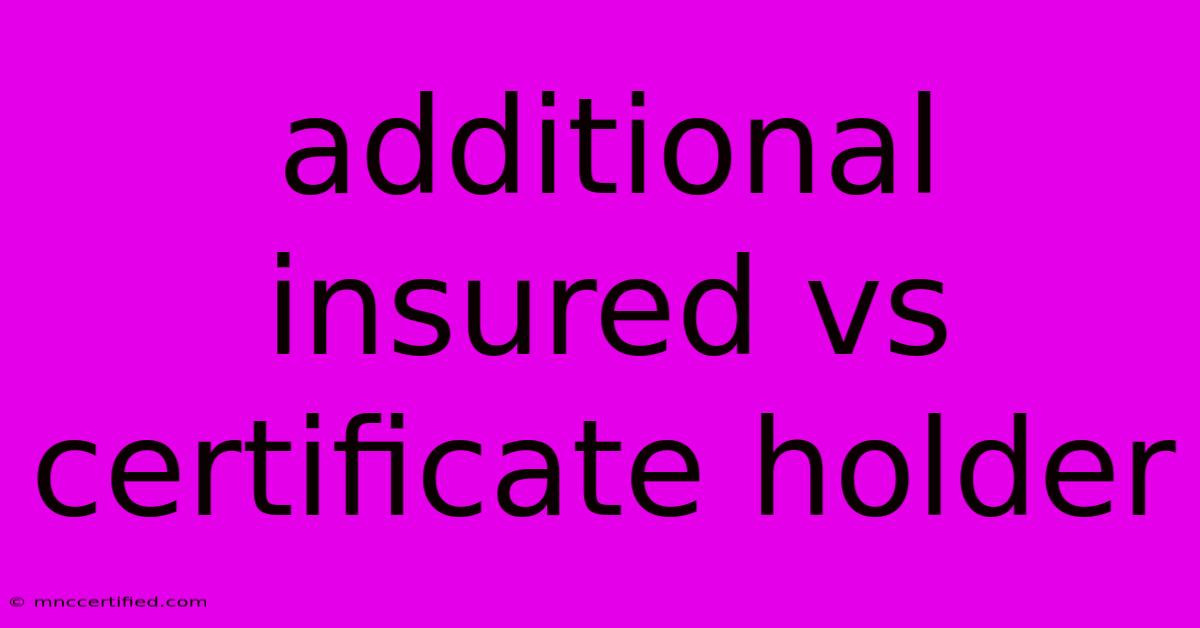Additional Insured Vs Certificate Holder

Table of Contents
Additional Insured vs. Certificate Holder: What's the Difference?
Navigating the world of insurance can be confusing, especially when terms like "additional insured" and "certificate holder" are thrown around. While they might sound similar, they represent distinct concepts with different implications for your business. This article will explain the difference between these terms, providing a clear understanding of their significance and why it's crucial to know the distinction.
Understanding Additional Insured
An additional insured is an individual or entity added to an existing insurance policy, specifically to receive coverage for potential liabilities arising from their involvement in the insured's operations. In essence, the additional insured is granted protection under the primary policyholder's insurance, offering an extra layer of security.
Examples of when an additional insured might be needed:
- Construction projects: A property owner might request that the general contractor be added as an additional insured on the owner's liability policy. This ensures the owner has coverage for any claims arising from the contractor's work on the property.
- Leasing agreements: A landlord might add a tenant as an additional insured on their property insurance policy, ensuring coverage for any incidents caused by the tenant's activities.
- Joint ventures: Partners in a business venture might agree to be added as additional insureds on each other's policies to protect themselves from liability.
Understanding Certificate Holder
A certificate holder is simply a recipient of an insurance certificate. This document verifies the existence of an insurance policy and the coverage provided. It does not actually add them to the policy as an insured party.
Key features of a certificate holder:
- They receive a copy of the insurance policy.
- They can confirm the existence of the insurance and its coverage details.
- They are not necessarily entitled to any coverage under the policy.
Examples of why a certificate holder might be needed:
- Contractors: A property owner might request a certificate of insurance from a contractor, verifying that they have the required liability insurance.
- Lenders: A lender might require a certificate of insurance from a borrower, ensuring that their assets are protected in case of an incident.
- Government agencies: Some government agencies might require a certificate of insurance from companies operating within their jurisdiction.
The Difference in a Nutshell
The key difference between an additional insured and a certificate holder lies in coverage. An additional insured is entitled to protection under the policy, while a certificate holder simply receives confirmation of coverage.
Think of it this way:
- Additional insured: You're a passenger in a car, and you're covered by the driver's insurance.
- Certificate holder: You're walking down the street, and you see a car with a sticker that says "insured." You know the car is insured, but you're not covered by that policy.
Why This Matters
Understanding the difference between an additional insured and a certificate holder is vital because it can impact your legal and financial protection. If you are involved in a project or situation where your interests might be exposed to liability, make sure to be properly designated as an additional insured on the relevant insurance policy.
Important Considerations:
- Contractual obligations: Carefully review contracts to determine whether you need to be named as an additional insured.
- Legal advice: Consult with a legal professional to understand the implications of your specific situation and ensure you have the necessary protection.
Conclusion
The distinction between an additional insured and a certificate holder is essential knowledge for businesses and individuals who engage in various activities, including construction, leasing, and partnerships. Always verify your status and ensure you are appropriately protected from potential liability by understanding your rights and obligations under relevant insurance policies.

Thank you for visiting our website wich cover about Additional Insured Vs Certificate Holder. We hope the information provided has been useful to you. Feel free to contact us if you have any questions or need further assistance. See you next time and dont miss to bookmark.
Featured Posts
-
Disability Insurance For Dental Hygienist
Nov 07, 2024
-
Campus Incident Resources Available
Nov 07, 2024
-
Dogecoin Jumps 25 After Trump White House Visit
Nov 07, 2024
-
Voters Approve Wisconsin Affirmative Action Ban
Nov 07, 2024
-
Trevor Sorbie No More Insert Event
Nov 07, 2024